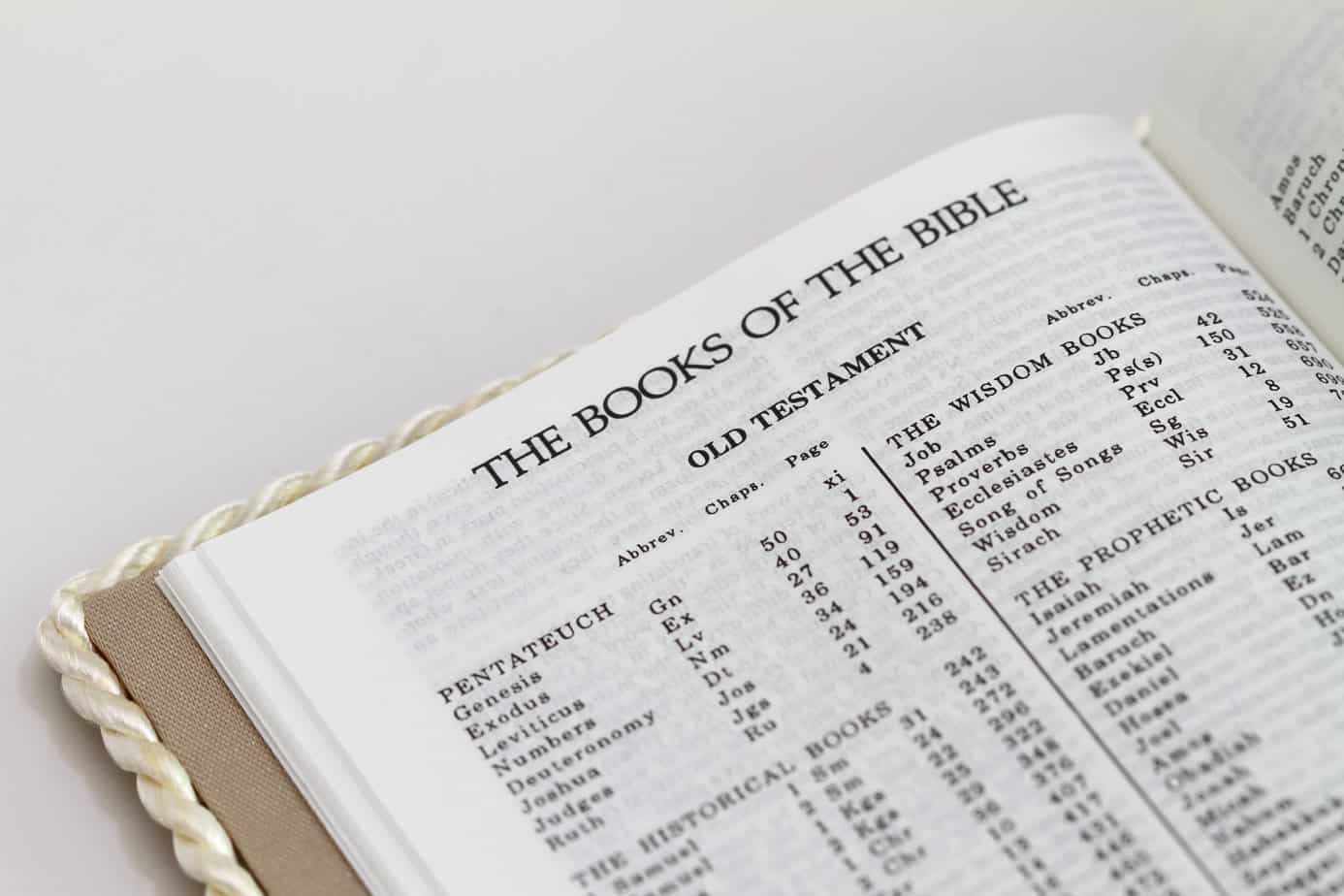This post is not quite the normal style that would be written here at LivingPraying.com. This is meant just to be a functional list of the books of the Bible in order and some highlights about each book. so, it reads like a list rather than a narrative. However, I hope that it can be a help to you as you take a look at this overview of the word of God.
Books of the Bible in Order
It’s the greatest book ever known. Actually, it is a library of 66 books inspired by God We have the written word at our fingertips!
On this page, we will list the books of the Bible in order, tell who wrote the book, the time period in which it was written, and the primary message(s) of the book.
We believe that the words found in the pages of the Bible contain the true story of God, mankind, and how and why we are here.
Most importantly, it points us to having a relationship with Jesus Christ now and forever.
It’s our hope that this document will help you and encourage you to read the Bible in its entirety and live a fulfilling life in a relationship with the true and living God.
The Bible is divided into two major parts – The Old Testament (or Old Covenant) and New Testament (or New Covenant).
Books of the Bible in Order
The Bible is arranged according to types of books rather than in chronological order.
However, at some point when you understand how the books of the Bible are arranged, then it can be enjoyable to read the Bible in Chronological order.
The Old Testament is divided into 4 primary segments or types of books:
- The Law – Genesis – Deuteronomy
- History – Joshua- Esther
- Poetry – Job – Song of Solomon
- Prophecy – Isaiah – Malachi
So, let’s have a look at an overview of the 66 books of the Bible, beginning with the Old Testament!

The Law
The Book of Genesis
- WHO- written by Moses to the Jewish nation. Key people were adam, Eve, Abraham, Isaac, Jacob, Joseph, and Noah.
- WHAT- this book is sometimes called the “seed plot’ of the whole Bible. It’s truly a book of “beginnings”
- WHEN- written between 1450 and 1410 B.C.
- WHERE- written in the wilderness somewhere in the Sinai Peninsula
The Book of Exodus
- WHO- Written by Moses to the Israelites. Key people were Moses, Aaron, Pharoah, Joshua
- WHAT- Chronicles the events surrounding the deliverance of Israel from Egypt.
- WHEN- Probably written within the same time frame as the book of Genesis.
- WHERE- likely written in the wilderness during Israel’s wanderings in the Sinai peninsula
The Book of Leviticus
- WHO- written by Moses. Key people were Moses, Aaron, Nadab, Abihu, Eleazar
- WHAT- provides laws and regulations meant to direct the sinful, but redeemed people of Israel in their interaction with a holy God. Teaches the Old Covenant sacrificial system
- WHEN- most likely at the same time and similar location as Exodus.
- Where- in the region of Mount Sinai
The Book of Numbers
- WHO- Written by Moses to the people of Israel. Key people were Moses, Aaron, Miriam, Joshua, Caleb
- WHAT- Tells how Israel prepared to go into the Promised Land. They tried and failed, then tried again.
- WHEN- around 1450-1410 B.C. during Israel’s wandering
- WHERE- in the wilderness in the desert of the Sinai Peninsula
Book of Deuteronomy
- WHO-written by Moses to the Israelites, with the exception of the final summary which may have been written by Joshua after Moses died
- WHAT– written to remind the children of Israel what their God had done for them and encourage them to set their minds on Him
- WHEN- written around 1407 B.C.
- WHERE– the setting is the east side of the Jordan river where they could see the Promised Land
History
Book of Joshua
- WHO- written by Joshua to the Israelites, except the ending which may have been written by the high priest, Phinehas. Key people are Joshua, Rahab, Achan, Phinehas
- WHAT- written to give the history of the children of Israel’s conquest of the Promised Land
- WHEN- time of writing is disputed by scholars
- WHERE- written in Canaan (The promised land), which is the general region of present-day Israel
Book of Judges
- WHO- possibly written by Samuel to the people of Israel. Key people are Gideon, Samson, Delilah, Othniel, Ehud, Deborah
- WHAT- written to demonstrate that God’s judgment against sin is certain, but that His forgiveness is also certain for those who repent
- WHEN- time of writing is disputed by scholars
- WHERE- also written in Canaan (The promised land), which is the general region of present-day Israel.
Book of Ruth
- WHO- the author is unknown, although some believe it may have been Samuel. Key people are Ruth, Naomi, BoazWHAT- tells the story of Ruth and demonstrates that people can be faithful to God even when their society collapses.
- WHEN- probably written after the period of the Judges 1375-1050 B.C.WHERE- the place of writing is unknown, but the setting is Israel and the country of Moab
Book of 1 Samuel
- WHO- possibly written by Samuel, but also seems to include words from the prophets Gad and Nathan. Key people are Eli, Samuel, Jonathan, David
- WHAT- tells the story of Ruth and demonstrates that people can be faithful to God even when their society collapses.
- WHEN- probably written during the days of the Judges.
- WHERE- the place of writing is unknown, but the setting is Israel and the country of Moab.
Book of 2 Samuel
- WHO- the primary author is generally unknown, but does include some writings of Nathan and Gad. Key people are David, Absalom, Joab
- WHAT- named after Samuel, who anointed David, it tells the history of King David’s reign
- WHEN- written around 930 B.C. not long after King David’s reign.
- WHERE- the setting of the story is the land of Israel while it was ruled by David
Book of 1 Kings
- WHO- the primary author is generally unknown, however, it was possibly written by Jeremiah or a group of Prophets. Key people are David, Solomon, Elijah, Ahab, Jezebel
- WHAT– written to Israel and follows Solomon’s rise to become King. Starts with a united Israel but ends with a divided kingdom of Israel and Judah
- WHEN- probably written between 540 and 560 B.C.
- WHERE- the setting of the story is the once great nation of Israel that has been turned into a land divided
Book of 2 Kings
- WHO- the author is also unknown but possibly written by Jeremiah or a group of Prophets. Key people are Elisha, Elijah, the woman from Shunem, Naaman, Jezebel, Nebuchadnezzar
- WHAT- written to Israel and follows through with the story of the Kings’ reign over the divided kingdoms of Judah and Israel. It demonstrates the fate of those who refuse to obey God.
- WHEN- also most likely written between 540 and 560 B.C.
- WHERE- the setting of the story is the once great nation of Israel that has been divided for over a century
1 Chronicles
- WHO- traditionally thought to have been written by Ezra to the Jewish exiles who returned from captivity in Babylon. Key people are David and Solomon
- WHAT- covers much of what was written in Kings and Samuel, with an emphasis on genuine worship and written more from a priestly point of view
- WHEN- written between 450 and 425 B.C. after the Babylonian exile
- WHERE- the setting is the nation of Israel as this book parallels much of 1 and 2 Samuel and 1 and 2 Kings
2 Chronicles
WHO- traditionally thought to have been written by Ezra to the Jewish exiles. Key people are Solomon, the queen of Sheba, Rehoboam, Jehoshaphat, Ahaz, Hezekiah
WHAT– covers the righteous kings of Judah and also the sins of the evil kings
WHEN- written between 450 and 425 B.C. after the Babylonian exile. 2 Chronicle evaluates Israel’s religious history
WHERE- the setting is the nation of Israel as this book parallels much of 1 and 2 Samuel and 1 and 2 Kings and serves as commentary to those books
Book of Ezra
- WHO- the author is not stated, but probably Ezra. Key people are Cyrus, Zerubbabel, Haggai, Zachariah
- WHAT- this book shows God’s faithfulness to keep His promise and restore his people to their land, and an emphasis on rebuilding the Temple. Notable locations are Babylon and Jerusalem
- WHEN- written between 460 and 440 B.C.
- WHERE- the setting is the nation of Israel as they return to their land after the Babylonian captivity
Book of Nehemiah
- WHO– it’s thought that Nehemiah wrote the book perhaps with Ezra serving as his editor
- WHAT– it’s the final one of the Old Testament historical books. Tells the story of the rebuilding of the wall of Jerusalem. Great book about leadership and teamwork
- WHEN- written between 445 and 432 B.C.
- WHERE- the setting is Nehemiah returning with a third group of exiles to rebuild the walls of the city of Jerusalem
Book of Esther
- WHO- Nehemiah may have written the book with Ezra as his editor. Key people are Esther, Mordecai, king Xerxes I, Haman
- WHAT- it features the story of Esther and her willingness to obey God in “such a time as this.”
- WHEN- Although the book follows Nehemiah, the events In Esther take place approximately 30 years prior to the book of Nehemiah
- WHERE– the setting is the Persian Empire and much of it in the king’s palace in Susa
Poetry
Book of Job
- WHO– the author is unknown but is possible Job, himself. Key people are Job, Eliphaz, Bildad, Elihu
- WHAT– it demonstrates the devastating trials of Job’s faith. Addresses the tremendous topic “why do the righteous suffer?”
- WHEN- Probably one of the Bible’s oldest books – written approximately 2000-1800 B.C.
- WHERE- The setting is the Land of Uz probably located in the northeast of Palestine possibly between the Euphrates River and Damascus.
This takes to the magnificent Book of the Psalms where David and other writers poured out their hearts in times of desperation and rejoicing. These songs and poetry have encouraged hundreds of millions of believers in good times and bad.
Book of Psalms
- WHO– primary author is David but includes writing by Asaph, Kirah, Solomon, Heman, Ethan, and even Moses. Some Psalms are anonymous. The key person in this book is David.
- WHAT– it provides poetry written for the people of Israel (and now anyone) to express praise, confession, and worship to God.
- WHEN- Written in a large span of time between Moses and the Babylonian captivity of the Jewish nation.
- WHERE- Although the setting isn’t intended to narrate historical events, the Psalms often display parallel events of history for the nation of Israel.
Book of Proverbs
- WHO– primary author is Solomon but includes writing by Agur and Lemuel in some of the later sections. Key persons are those of us who will read it.
- WHAT– A book of wise sayings on how to attain wisdom and do what is right, just, and fair. Originally written to the people of Israel.
- WHEN- Written and compiled mostly in the early reign of Solomon.
- WHERE- Most likely written around Jerusalem as this is where the temple was.
Book of Ecclesiastes
- WHO- the author is Solomon- written to his subjects (and to us all)
- WHAT- Additional wise teachings about life from King Solomon
- WHEN- Written around 935 B.C.
- WHERE- The setting was probably in Jerusalem when Solomon was looking back on his illustrious life
The Song of Solomon (Song of Songs)
- WHO- the author is King Solomon wrote to his subjects (and to us all). Key people are Solomon, the young woman of Shulam, and friends
- WHAT- tells of the love between Solomon and his Bride. Illustrate the sanctity and beauty of marriage – picturing God’s love for His people
- WHEN- probably written early in King Solomon’s reign
- WHERE- The setting was Israel – sometimes in the Shulammite woman’s garden and the King’s palace.
Prophecy
The Book of Isaiah
- WHO- the author is the prophet, Isaiah. Key people are Isaiah and his sons
- WHAT- an incredible book that was written to call the nation of Judah back to God and to foretell the coming of the Messiah (who would be Jesus)
- WHEN- written between 739 and 681 B.C.
- WHERE- in and around Jerusalem
Book of Jeremiah
- WHO- Jeremiah writing to Judah. Key people are Judah’s kings, Baruch, Nebuchadnezzar
- WHAT- it records the final prophecies to Judah to urge them to repent and turn back to God
- WHEN- written between 630 and 580 B.C.
- WHERE- the setting is with Isaiah speaking and writing primarily in Jerusalem
Book of Lamentations
- WHO- the author is considered as Jeremiah writing to the exiled people of Judah. Key people were Jeremiah and the people of Jerusalem
- WHAT- it is a lament because Judah received God’s judgment for not repenting.
- WHEN- written between 586 and 575 B.C.
- WHERE- As an eyewitness of the fall of Jerusalem, Jeremiah wrote these words
Book of Ezekiel
- WHO- Ezekiel was the author of the book. Key people Ezekiel, Israel’s leaders, Ezekiel’s wife, NebuchadnezzarJerusalem
- WHAT- to announce God’s judgment on Israel and others but foretells the salvation that would come eventually
- WHEN- written between 593 and 565 B.C.
- WHERE- Ezekiel’s prophecy to the exiles in Babylon. He was taken there in 597 B.C
Book of Daniel
- WHO- Daniel originally wrote this to the other captives in Babylon. Key people were Daniel, Nebuchadnezzar, Shadrach, Meschach, Abednego
- WHAT- this book records the exciting events and prophecies of the prophet Daniel
- WHEN- likely written between 540 and 530 B.C.
- WHERE- Daniel had been captured by Nebuchadnezzar and deported to Babylon
Book of Hosea
- WHO- Hosea was the author. Key people. Hosea, Gomer, and their children
- WHAT- this book illustrates God’s long-suffering love illustrated by a faithful husband to an unfaithful wife
- WHEN- likely written between 755 and 725 B.C.
- WHERE- Hosea’s ministry was in the declining years of the reign of Jeroboam II.
Book of Joel
- WHO- written to the people of Judah by Joel. Key people were Joel and the people of Judah
- WHAT- written to warn Judah to turn from their sins back to God
- WHEN- written between 835 and 800 B.C.
- WHERE- In Judah where they had just been devastated by an enormous horde of locusts
Book of Amos
- WHO- written by Amos to the people of Israel (the northern kingdom). Key people were Amos, Amaziah, and Jeroboam II
- WHAT- written to pronounce God’s judgment on Israel (northern Kingdom) because of their idolatry, oppression of the poor, and other sins
- WHEN- likely written between 835 and 800 B.C.
- WHERE- In the Northern Kingdom where they were they had prosperity but oppressed the poor, even selling some into slavery
Book of Obadiah
- WHO- written by the prophet, Obadiah to the Edomites and the Jews in Judah. Key people were the Edomites
- WHAT- shows that the Lord God will eventually judge those who harm His people
- WHEN- written between 848 and 840 B.C.
- WHERE- In Judah as Obadiah is sending a strong message to the Edomites
Book of Jonah
- WHO- written by Jonah, originally to all the people of Israel. Key people Jonah, the ship’s captain, and crew
- WHAT- As Jonah was swallowed and spit out by a large fish, it shows that disobedience to the Lord can be followed by a change of heart
- WHEN- likely written between 793 and 758 B.C.
- WHERE- Jonah ministered under the reign of Jeroboam II and ended up going to Nineveh to get the people there to repent
Book of Micah
- WHO- written by Micah to the people of Israel and Judah
- WHAT- written to warn that judgment was coming but there was pardon for those who would repent
- WHEN- likely written between 735 and 700 B.C.
- WHERE- Micah was in Judah and writing to both the northern and southern kingdoms
Book of Nahum
- WHO- written by Nahum. Key people are people of Judah and people of Assyria
- WHAT- this book pronounces judgment for Assyria thereby lending comfort to the people of Judah
- WHEN- likely written between 663 and 612 B.C.
- WHERE- written in context around the time that God sent His judgment on Nineveh
Book of Habakkuk
- WHO- written by Habakkuk. Key people are Habakkuk and the Babylonians
- WHAT- this book tells us that God is still in control even when we think evil has conquered
- WHEN- likely written between 610 and 605 B.C.
- WHERE- the key place was Judah which would soon feel destruction by Babylon
Book of Zephaniah
- WHO- the author was Zephaniah to the people of Judah.
- WHAT- Zephaniah wanted to compel the people of Judah out of their complacency and for them to turn back to God
- WHEN- likely written between 635 and 625 B.C.
- WHERE- the key place was Judah under the reign of King Josiah
Book of Haggai
- WHO- the author was Haggai to the people of Judah. Key people were Haggai, Zerubbabel, Jeshua
- WHAT- Haggai was calling for the people of God to complete the rebuilding of the temple
- WHEN- likely written around 520 B.C
- WHERE- God’s people had begun rebuilding the temple in Jerusalem but it was unfinished
Book of Zechariah
- WHO– the author was Zechariah to the people of Judah. Key people were Zerubbabel, Jeshua
- WHAT– Zechariah was encouraging God’s people by telling them that the Messiah would come to bring deliverance
- WHEN- likely written between 635 and 625 B.C.
- WHERE- In the area in and surrounding Jerusalem
Book of Malachi
- WHO- the author was Malachi. Key people were Malachi, the priests
- WHAT- Zechariah was confronting the people with their sins wanting them to turn back to a relationship with God
- WHEN- likely written between 440 and 400 B.C.
- WHERE- In the area in and around Jerusalem
Looking Toward the New Testament (New Covenant)
We hope that the books of the Bible in order is being helpful to you. That was such a brief flyover of the books of the Old Testament or Old Covenant.
Jesus was coming on the scene to live and die to open up a way for us to receive forgiveness for our sins.
He would fulfill the law of Moses and bring in a New Covenant of the heart.
That was such a brief flyover of the books of the Old Testament or Old Covenant. Jesus was coming on the scene to live and die to open up a way for us to receive forgiveness for our sins. He would fulfill the law of Moses and bring in a New Covenant of the heart.
The New Testament is grouped into 4 sections:
The Gospels – Matthew – John
Church History – Acts
The Letters (or Epistles) Romans – Jude
Prophecy – Book of Revelation
Now let’s continue with the books of the Bible in order as we proceed into the New Testament.
The Four Gospels
The Gospel of Matthew
- WHO- the author was Matthew (also called Levi). Key people were Jesus, Mary, Joseph, John the Baptist, the disciples, Mary Magdalene, and many others
- WHAT- Matthew’s intent is to prove that Jesus Christ is the promised Messiah
- WHEN– written in the early period of the church probably during A.D. 55-65
- WHERE (key places)– Bethlehem, Galilee, Capernaum, Jerusalem
The Gospel of Mark
- WHO- the author was John Mark. He was not one of the 12 disciples. Key people were Jesus, the 12 disciples, Pilot, the Jewish leaders
- WHAT- John Mark’s intent was to present the person, teachings, and work of Jesus Christ
- WHEN- probably in A.D. 55-59
- WHERE (key places)– Capernaum, Nazareth, Caesarea, Philippi, Jerusalem, Golgotha
The Gospel of Luke
- WHO- the author was Luke, who was a doctor. Key people were Jesus, Elizabeth, Zechariah, John the Baptist, the disciples, Mary Magdalene
- WHAT- an accurate account of the life of Christ as both a human and as the Son of God
- WHEN- written in the early period of the church probably in 58-65 A.D.
- WHERE (key places)- Bethlehem, Galilee, Judea, Jerusalem
The Gospel of John
- WHO- the author was John the Apostle, written originally to new Christians and non-Christians. Key people are Jesus, the disciples, Mary, Martha, Lazarus, Mary Magdalene
- WHAT- John wants to establish conclusively that Jesus is the Son of God and all who believe in Him will have eternal life
- WHEN- around A.D. 85-90
- WHERE (key places)- Judean countryside, Samaria, Galilee, Bethany, Jerusalem
Church History
Book of Acts
- WHO- the author was Luke written originally to Theophilus. Peter, John, James, Stephen, Phillip, Paul
- WHAT- the purpose was to give an accurate account of the beginning and growth of the Christian church
- WHEN- written between A.D. 63-70
- WHERE (key places)- Jerusalem, Samaria, Antioch, Joppa, Athens, Corinth, Caesarea, Rome
Letters
Now we move on to the letters that are super important for today’s believers. So, let’s continue looking at the books of the Bible in order.
Book of Romans
- WHO- the author was the Apostle, Paul. Key people were Paul, Phoebe
- WHAT- this book is a great work of Christian doctrine and encouragement as Paul introduces himself and this message to the church in Rome
- WHEN- likely written between A.D. 56-58
- WHERE (key place)- Rome
1 Corinthians
- WHO- the author was the Apostle, Paul and it was written to the Corinthian church. Key people were Paul, Timothy
- WHAT- Paul wrote this letter to identify some problems in the church at Corinth and correct their understanding of some important Christian doctrines
- WHEN- written approximately A.D. 55
- WHERE (key places)- Worship meetings in Corinth
2 Corinthians
- WHO- the author was the Apostle, Paul wrote to the Corinthian church. Key people were Paul, Timothy, Titus, false teachers
- WHAT- written as an affirmation of Paul’s ministry and his authority as an Apostle. He also warns of false teachers spreading untrue teachings
- WHEN- written approximately A.D. 55-57
- WHERE (key places)- Corinth, Jerusalem
Book of Galatians
- WHO- the author was the Apostle, Paul and was written to the churches in southern Galatia. Key people were Paul, Peter, Barnabus, Titus, false teachers
- WHAT- written to correct the teachings of the Judaizers that Gentile believers must obey the Jewish law to be saved
- WHEN- perhaps the first New Testament book to be written, soon after A.D. 49
- WHERE (key places)- Galatia, Jerusalem
Book of Ephesians
- WHO- the author was the Apostle, Paul and was written to the church at Ephesus and then circulated to other churches. Key people were Paul, Tychicus
- WHAT- written to strengthen the believers by telling them their right standing in Christ and also teaching key principles of Christian living
- WHEN- likely written A.D. 60-63
- WHERE (key place)- Ephesus
Book of Philippians
- WHO- the author was the Apostle, Paul, and was written to the Christians at Phillipi. Key people were Paul, Timothy, Epaphroditus
- WHAT- Paul thanks the Philippians for the gift they had sent and encourages the believers that true joy is found in Jesus Christ
- WHEN- written approximately A.D. 61
- WHERE (key place)- Phillipi
Book of Colossians
- WHO- the author was the Apostle, Paul and was written to the Church at Colosse. Key people were Paul, Timothy, Tychicus, Onesimus
- WHAT- Paul warns the Colossian people about errors in their teaching and to encourage continued spiritual growth in Christ
- WHEN- written approximately A.D. 58-62
- WHERE (key places)- Colosse, Laodicea
1 Thessalonians
- WHO- the author was the Apostle, Paul and was written to the Church at Thessalonica. Key people were Paul, Timothy, Silas
- WHAT- Paul wants to strengthen the faith of believers and clear up the misunderstandings about the return of Jesus Christ
- WHEN- written approximately A.D. 50
- WHERE (key place)- Thessalonica
2 Thessalonians
- WHO- the author was the Apostle, Paul and was written to the Church at Thessalonica. Key people were Paul, Timothy, Silas
- WHAT- Paul continues to clear up misunderstandings about the return of Christ and to comfort the believers
- WHEN- written approximately A.D. 51-52
- WHERE (key place)- Thessalonica
1 Timothy
- WHO- the author was the Apostle, Paul, and was written to Timothy, a young pastor who was very close to Paul. Key people were Paul, Timothy
- WHAT- Paul gives instruction and encouragement to Timothy regarding His responsibilities as a pastor
- WHEN- written approximately A.D. 62-66
- WHERE (key place)- Ephesus
2 Timothy
- WHO- the author was the Apostle, Paul, and was written to Timothy. Key people were Paul, Timothy, Luke, Mark
- WHAT- while imprisoned for his faith again, Paul uses some of his last time on earth to encourage young Timothy as a pastor at Ephesus
- WHEN- written approximately A.D. 67
- WHERE (key places)- Ephesus, Rome
Book of Titus
- WHO- the author was the Apostle, Paul and was written to Titus, who supervised the churches on the island of Crete. Key people were Paul, Titus
- WHAT- Paul wrote to encourage Titus and to offer guidance in qualifications for the selection of church leaders
- WHEN- written approximately A.D. 66
- WHERE (key places)- Crete, Nicopolis
Book of Philemon
- WHO- the author was the Apostle, Paul and was written to Philemon, who might have been a wealthy man in the church at Colosse. Key people were Paul, Philemon, Onesimus
- WHAT- This letter deals with the practice of slavery, which in this situation, was a very different form of slavery from what modern-day westerners know of
- WHEN- written approximately A.D. 60
- WHERE (key places)- Colosse, Rome
Book of Hebrews
- WHO- there is much debate about the authorship of Hebrews. Many scholars attribute the work to Paul. The original audience was Hebrew Christians. Key people were Old Testament men and women of the faith
- WHAT- written to present that the sacrifice of Jesus Christ was all-sufficient and salvation couldn’t be obtained through the Jewish law
- WHEN- written approximately A.D. 65
- WHERE (key places)- the early churches
Book of James
- WHO- written by James, Jesus’ brother. Key people were James and Jewish Christians
- WHAT- written to help correct hypocritical practices and to encourage proper Christian behavior
- WHEN- written approximately A.D. 49
- WHERE (key places)- the early churches
Book of 1 Peter
- WHO- written by Peter to the churches throughout the ancient world. Key people were Peter, Silas, Mark
- WHAT- written to encourage believers who were under severe persecution assuring them of their future in Christ
- WHEN- written approximately A.D. 60-65
- WHERE (key places)- Jerusalem, Rome, Galatia, Asia Minor, Bithynia, Cappadocia
Book of 2 Peter
- WHO- written by Peter to the churches throughout the ancient world. Key people were Peter, Paul
- WHAT- written to encourage believers to reject false teachers and to be encouraged as believers
- WHEN- likely written between A.D. 65-68
- WHERE (key places)- the early church at large
Book of 1 John
- WHO- written by the Apostle, John, and sent to several congregations of Gentile believers Key people were John, Jesus
- WHAT- written to warn again about false spiritual leaders and to reassure the Christians about their faith in Christ
- WHEN- likely written between A.D. 85-95
- WHERE (key places)- areas of the early church
Book of 2 John
- WHO- written by the Apostle, John, and sent to “a chosen lady,” possibly to signify the local church. Key people were John, the chosen lady, and her children
- WHAT- reminding Christians about the basics of love and also and to warn against false doctrines being taught
- WHEN- written between A.D. 85-95
- WHERE (key places)- areas of the early church
Book of 3 John
- WHO- written by the Apostle, John, to Gaius who was a prominent Christian in one of the early churches. Key people were John, Gaius, Demetrius, Diotrephes
- WHAT- written to encourage Gaius in his faith and for his Christian hospitality
- WHEN- written approximately between A.D. 85-95
- WHERE (key place) – Ephesus
Book of Jude
- WHO- written by Jude, the brother of James, to Jewish Christians. Key people were Jude, James, Jesus
- WHAT- written to encourage Christians to stay strong, contend for the Christian faith, and oppose heresy
- WHEN- written between A.D. 60-80
- WHERE (key places)- The early churches
The Last Book
Here we go into the last book of the Bible that speaks of coming end-time events. Let’s finish up our walk through the books of the Bible in order.
Book of Revelation
- WHO- written by the Apostle, John, to the 7 churches in Asia and, ultimately, to all believers everywhere. Key people were Jude, John, Jesus
- WHAT- written to give a warning (and hope) about the last days before the return of Christ and the coming of the new Heaven and new Earth
- WHEN- written between A.D. 90-95
- WHERE (key places)- Patmos, the 7 churches, the New Jerusalem
Conclusion
Thank you for taking a look at the books of the bible in order.
It’s our prayer that this overview of the 66 books contained in the Bible will help you get a glimpse of the overall outline of the scriptures. You can read the books of the Bible in order in a regular Bible. It’s also enjoyable to read the Bible in a chronological way sometimes.
The ultimate message of the Bible is the plan of salvation that is offered to everyone for the forgiveness of their sins and a life of fulfillment through a relationship with Jesus Christ.
It’s our prayer that you will seek a relationship with Jesus Christ today!
To learn more, check out our page that speaks of the plan of salvation.





Leave a Reply